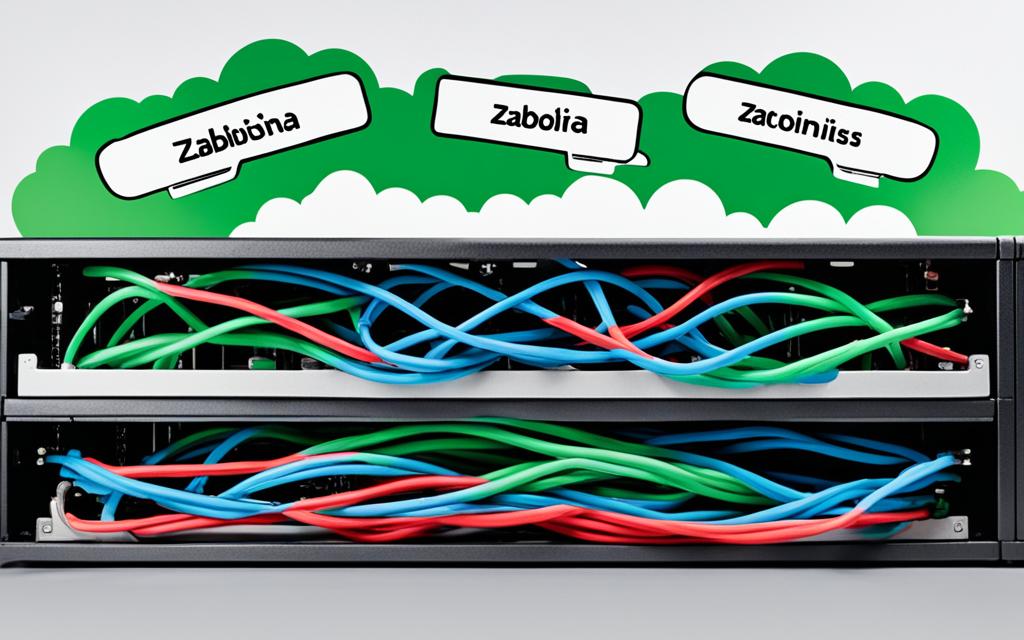Proprietary cloud tools have revolutionized network management, providing IT teams with efficient solutions for streamlined operations. These tools offer a range of functionalities that enhance network monitoring, performance optimization, and security in modern IT environments. In this article, we will delve into the world of proprietary cloud tools and their significance in network management.
From network monitoring to troubleshooting and capacity planning, proprietary cloud tools empower organizations to effectively manage their network infrastructure. These tools are designed to provide comprehensive visibility into network performance, ensuring optimal operations and minimizing downtime. With features tailored to address the unique challenges of the cloud environment, they offer seamless integrations, real-time data analysis, and proactive monitoring capabilities.
As businesses increasingly rely on cloud-based services and applications, the demand for reliable network management tools has escalated. Proprietary cloud tools not only simplify network monitoring but also offer advanced capabilities such as traffic analysis, security threat detection, and resource optimization. By leveraging these tools, organizations can ensure the smooth and secure functioning of their network infrastructure.
In the next sections, we will explore the pros and cons of open source cloud monitoring, delve into five mature open source cloud monitoring tools, discuss the importance of cloud monitoring in modern IT environments, and conclude by highlighting the significance of choosing the right cloud monitoring tools for efficient network management.
Pros and Cons of Open Source Cloud Monitoring
When it comes to cloud monitoring, open source tools have gained considerable popularity among organizations. They offer several advantages, including cost-effectiveness, compatibility with any environment or configuration, data ownership, and ease of integration with other tools. However, like any solution, there are also disadvantages to consider.
Advantages of Open Source Cloud Monitoring:
- Cost-effectiveness: Open source cloud monitoring tools are typically free, allowing organizations to allocate their budget towards other critical areas.
- Compatibility: These tools can be used in any environment or configuration, making them highly flexible and adaptable.
- Data ownership: With open source tools, organizations have complete control over their data, ensuring privacy and security.
- Integration: Open source cloud monitoring tools often have extensive integration capabilities, enabling seamless collaboration with other tools in the IT ecosystem.
Disadvantages of Open Source Cloud Monitoring:
- Deployment and management complexity: Deploying and managing open source cloud monitoring tools may require advanced technical knowledge, which can lead to higher indirect staff costs.
- Limited professional support: Compared to proprietary tools, finding professional support for open source tools might be more challenging.
- Differences in maturity and feature richness: Not all open source tools are created equal. Some may be more mature and feature-rich than others, potentially affecting the overall monitoring capabilities.
It’s crucial for organizations to weigh these pros and cons before deciding on open source cloud monitoring tools. While the cost-effectiveness and flexibility can be appealing, businesses need to consider their technical expertise, support requirements, and specific monitoring needs.
“Open source cloud monitoring provides cost-effectiveness and compatibility, but deploying and managing these tools may require advanced technical knowledge.” – IT Expert
| Advantages | Disadvantages |
|---|---|
| Cost-effectiveness | Deployment and management complexity |
| Compatibility | Limited professional support |
| Data ownership | Differences in maturity and feature richness |
| Integration |
Five Mature Open Source Cloud Monitoring Tools
When it comes to open source cloud monitoring, there are several mature tools available that can meet the monitoring needs of different organizations. Each tool offers unique features and functionalities, allowing IT teams to effectively monitor their cloud infrastructure and ensure optimal performance. Let’s take a closer look at five popular open source cloud monitoring tools:
Zabbix
Zabbix is a flexible monitoring tool that provides customizable configurations, making it suitable for a variety of monitoring requirements. With its robust feature set, Zabbix offers extensive monitoring capabilities across various platforms and devices. It allows for the collection, analysis, and visualization of valuable data, enabling organizations to proactively identify and address issues to ensure uninterrupted service delivery.
Nagios
Nagios is another versatile open source tool that is widely used for monitoring cloud infrastructure. It offers flexibility and dual versions, Nagios Core and Nagios XI, providing users with additional features such as advanced reporting and visualization. Nagios allows for comprehensive monitoring of various components, including servers, network devices, applications, and services, helping organizations maintain the health and availability of their cloud resources.
Icinga
Icinga is a fork of Nagios that provides similar monitoring capabilities with a more intuitive and user-friendly interface. It offers an enhanced web interface and improved usability while maintaining compatibility with Nagios plugins. Icinga enables IT teams to monitor the performance and availability of their cloud infrastructure, facilitating efficient troubleshooting and ensuring the delivery of high-quality services.
Grafana
Grafana is a powerful visualization tool that integrates seamlessly with various data collectors, including Zabbix, Nagios, and Icinga. It allows organizations to create dynamic and customizable dashboards to visualize and analyze cloud monitoring data. Grafana’s intuitive interface and extensive library of plugins make it a popular choice for IT teams looking to gain valuable insights from their monitoring metrics.
Zenoss
Zenoss focuses on cloud monitoring and offers predictive features that help organizations identify and address potential issues before they impact performance. It provides comprehensive visibility into the cloud infrastructure, allowing IT teams to gain insights into resource utilization, network traffic, and application performance. Zenoss offers a centralized platform for managing cloud monitoring, making it easier for organizations to proactively monitor and optimize their cloud environments.
Each of these open source monitoring tools comes with its own strengths and limitations. Depending on the specific needs and requirements of an organization, one tool may be more suitable than others. It is recommended to evaluate the features, capabilities, and compatibility of each tool to make an informed decision about the best fit for your cloud monitoring needs.

Note: The image above represents the concept of cloud monitoring tools and is not specific to any particular tool mentioned in this section.
The Importance of Cloud Monitoring in Modern IT Environments
Cloud monitoring plays a crucial role in modern IT environments, providing visibility into the performance and stability of cloud-based infrastructure, services, applications, and connectivity. With the increasing adoption of hybrid and multi-cloud deployments, clear visibility across the entire infrastructure is essential to ensure optimal performance, productivity, and end-user experience.
Cloud monitoring tools enable organizations to identify and address various issues, including performance problems, security incidents, and potential breaches. By continuously monitoring the cloud environment, IT teams can proactively detect and mitigate any issues that may impact the overall efficiency and security of their systems.
The key benefits of cloud monitoring in modern IT environments include:
- Improved Visibility: Cloud monitoring provides real-time insights into the health, availability, and performance of cloud resources, allowing IT teams to detect and troubleshoot issues promptly.
- Performance Optimization: By monitoring the performance of cloud-based applications and infrastructure, organizations can identify bottlenecks, optimize resource allocation, and ensure optimal performance and user experience.
- Enhanced Security: Cloud monitoring tools help in identifying potential vulnerabilities, detecting unauthorized access attempts, and monitoring data transfers to protect against security breaches and ensure compliance with regulatory standards.
With the rapid growth of cloud-based services and the complexity of modern IT infrastructures, relying solely on manual monitoring can be impractical and time-consuming. Cloud monitoring tools automate data collection, analysis, and reporting, providing IT teams with comprehensive insights and actionable intelligence to make informed decisions.
Ultimately, cloud monitoring is essential for organizations that want to leverage the benefits of cloud technology while ensuring the availability, performance, and security of their IT systems. By investing in robust cloud monitoring tools and practices, businesses can proactively address issues, optimize resource allocation, and deliver enhanced services to their customers.
Conclusion
Cloud monitoring tools play a vital role in efficient network management and streamlined operations in modern IT environments. While proprietary cloud tools offer specific functionalities, open source alternatives provide cost-effective options with greater flexibility and compatibility.
By leveraging mature open source cloud monitoring tools like Zabbix, Nagios, Icinga, Grafana, and Zenoss, organizations can achieve comprehensive network monitoring and optimize their cloud infrastructure’s performance and security. These tools offer customizable configurations, intuitive interfaces, and seamless integration capabilities.
With the increasing adoption of hybrid and multi-cloud deployments, the importance of cloud monitoring cannot be overstated. It provides organizations with clear visibility into the performance, stability, and security of their cloud-based infrastructure, applications, and connectivity. This visibility allows them to proactively identify and address performance issues, security incidents, and potential breaches, ensuring optimal performance, productivity, and end-user experience.
For efficient operations and effective network management, organizations should consider implementing the right combination of proprietary and open source cloud monitoring tools. This strategic approach empowers IT teams to monitor, analyze, and optimize their cloud environments, unlocking the full potential of their IT infrastructure and ensuring the highest levels of performance and security.
FAQ
What are the advantages of open source cloud monitoring tools?
Open source cloud monitoring tools offer cost-effectiveness, compatibility with any environment or configuration, data ownership, and ease of integration with other tools.
What are the disadvantages of using open source cloud monitoring tools?
While open source cloud monitoring tools provide several benefits, they may be more difficult to deploy and manage, resulting in higher indirect staff costs. It can also be challenging to find professional support for open source tools, and there may be differences in maturity and feature richness among different options.
What are some mature open source cloud monitoring tools to consider?
Five mature open source cloud monitoring tools to consider are Zabbix, Nagios, Icinga, Grafana, and Zenoss.
How do Zabbix and Nagios differ?
Zabbix is a flexible monitoring tool with customizable configurations, while Nagios offers flexibility and dual versions for additional features.
What is the difference between Nagios and Icinga?
Icinga is a fork of Nagios and provides similar features with a more intuitive interface.
What is Grafana used for?
Grafana is a visualization tool that integrates with other data collectors.
What are the key features of Zenoss?
Zenoss focuses on cloud monitoring with predictive features.
Why is cloud monitoring important in modern IT environments?
Cloud monitoring plays a crucial role in providing visibility into the performance and stability of cloud-based infrastructure, services, applications, and connectivity. It enables organizations to identify and address performance problems, security incidents, and potential breaches.
Why should organizations leverage open source cloud monitoring tools?
Open source cloud monitoring tools provide cost-effective options with greater flexibility and compatibility, allowing organizations to achieve comprehensive network monitoring and optimize their cloud infrastructure’s performance and security.



















